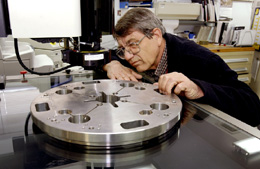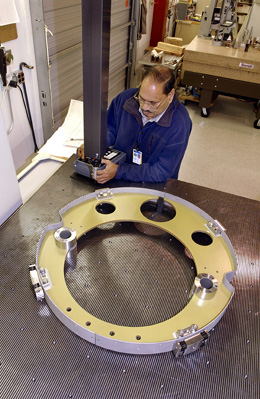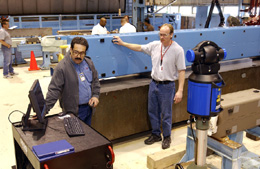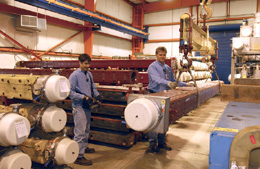 |
|
Answering the Call by Mike Perricone
It's 3 a.m.at Fermilab. Do you know where your backup 10-ton magnet is? Do you know what it takes to test it, install it, and get it operating? You’re developing specifications for a critical component,the coupler,for the linear collider R & D project. Which design is best from the manufacturing standpoint,and which vendor can produce it within tolerances smaller than the thickness of a human hair? Parts are coming in for the production of Large Hadron Collider magnets bound for CERN,the European Particle Physics Laboratory. Do the parts meet specifications? Does your vacuum vessel leak? Does a mechanical measuring tool need calibration? Whatever you need, does it meet the standard of being fit for use? In all these cases, and many more, the people to call are the Technical Division’s Material Control Department. Operating largely out of sight, this efficient squad of some 17 lab veterans with an admirable safety record functions as one of the vital organs of Fermilab. “We’re kind of like your kidneys,” said department head Gregg Kobliska.“If they’re functioning well, and they’re staying behind the scenes, you’re happy.If they’re not functioning well, they’ll get your attention in a hurry.” In Material Control,avoiding that kind of attention is the way they like it. “There’s a long list of things they handle flawlessly,”said Rich Stanek,deputy head of the Technical Division.
That long list ranges from moving multi-ton magnets to measur- ing magnet laminations just thousandths of an inch thick,from compiling exhaustive inventories of tooling and kits to inspecting cranes and lift trucks,and Material Control handles them flawlessly and safely. The department hasn ’t had a lost-time accident since 1995. “Our goal is always no incidents,no accidents,”Kobliska said.“I think our record is indicative of people taking things seriously.” The record is also indicative of taking seriously what people have to say about the work they are doing.For example,a portion of the parking lot outside IB4,where magnets are inspected and stored,has been recently resurfaced.That was done as a safety measure. “Before that,it was really rough,”said Kobliska. “The change came about from people saying, ‘When we ’re moving these big magnets on trailers, the surface is so rough that something ’s going to happen.’They told me,and I got the support of Technical Division headquarters to have the area repaired.The credit for safety goes to all levels, to the people who bring it up in the first place, and to the people who control the funds and show they ’re serious about safety by matching their words with money.” The department is organized in three areas.The Acquisition Group works closely with the lab’s Business Services Section in choosing vendors and ordering technical components.Magnet and Component Storage houses and keeps tabs on an inventory of nearly 1,000 magnets,and organizes parts and tooling neatly enough to keep a grandmother happy.Quality Control uses an array of coordinate measuring machines (CMM’s) including a portable laser unit for oversized components, instruments for gauging the magnetic properties of steel,leak testers, hardness testers,and rows and rows of meticulously-kept file drawers of micrometers, calipers,thread gauges and more. “Material Control functions like the supply line to the troops,getting them what they need to do their work,when they need it,” said Technical Division head Bob Kephart.“Any time the lab ramps up an effort,such as for the LHC, Material Control is always very active. Each time we’re looking at manufact-uring an accelerator out of individual pieces, they’ll take the items and see how they can be industrialized for mass production.Any time we produce a new magnet, that usually represents a significant investment in new tooling.If you produce that magnet again, it means you need the same tooling. The component storage group maintains all that tooling,and sets it all up to do the job. They’re a small group that’s important beyond their size.”
Doug Kelley in the storage group maintains an on-line inventory of parts and tooling,and all the tooling features digital photos to help in identification. “The database is about 25 pages,with 30 to 40 items per page,”Kelley said.“We ’re responsible for all the components coming in,and keeping track of their quantities and where abouts. Whenever the accelerator ring needs a magnet, we ’re on call to get it.We basically take in all the parts needed for building a project here in TD. Then they go through inspection and quality control.We put them in stock to be used in a kit later on.If we get a request for a particular magnet,all these related parts are pulled and put into a kit,and given to the Fabrication Group.” Stability is an important ingredient in the department ’s success.As examples:Kobliska has been at the lab since 1978,Rob Riley of Quality Control is about to mark his 20th anniversary at the lab;Steve Merkler of Quality Control has seen service for nearly 22 years.
“I think there’s a message there,” Kobliska said. “Every function in Material Control is important. Whenever anybody hires in, we always make sure they understand that. Because if John Zwiebohmer’s people in Acquisitions are thinking they’ve got parts that they don’t actually have because Doug’s group hasn’t done the proper paperwork, then we’ve failed. Or if Acquisitions has done the right thing, and Doug’s group has done the right thing,but QC didn’t find a defect in the parts,again we’ve failed. Or if these people have all done the right thing,and John’s group didn’t order the right number of parts in first place, we've failed.Everybody is working together, everybody’s job is important, for us to be successful.” The outlook of appreciating every contribution carries over into the bigger picture of any effort. Kelley took note of the work on the Compact Muon Solenoid detector bound for CERN,and the collaboration among U.S.and European labs and institutions in Russia and China.
“We ’re working on our final shipment to Russia, and that should complete the CMS project,”Kelley said.“The countries worked together successfully. The world can be going off in all directions,but here at Fermilab we have it all going together.” From Europe and Asia to northern Minnesota for the MINOS neutrino project,to southern Argentina for the Pierre Auger Observatory,to every part of the site,the reach of Material Control extends throughout the lab ’s mission. “We rely on good people,and we give them the latitude and the freedom to do their jobs,”Kobliska said.“Things get sufficiently complicated that if any one person tried to stay on top of everything,or tried to take credit for everything,if would be rather phony.” Still,some things are beyond even this group ’s ability to control.The phone on Kobliska ’s conference table rings once,and stops,and Kobliska gives it a bemused look. “That phone rings every half-hour,”he says. “Nobody can figure out why.” Measuring up - micron by micron
ON THE WEB: Technical Division Material Control Department: http://www-td.fnal.gov/departments/material-control.html |



